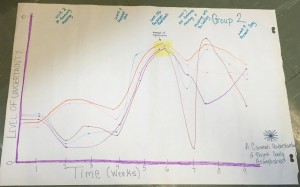“If you want to see the sunshine, you have to weather the storm” – Frank Lane, n.d.

Figure 1: Untitled online image of a rainbow. (Long, 2015).
Welcome to our third group blog posting! As we move into the 10th week of LFS350, we are starting to see the light at the end of the project. We have put a lot of effort into growing a project that we hope will be beneficial to our community partner Joanne, community members of the Little Mountain Riley Park (LMRP) area, as well as our own personal development. Our scope has shifted significantly since our last blog post, requiring us to refocus our efforts. While this has at times caused us to feel pressured for time and resources, we now feel confident that we are moving in the right direction. The following quote from the novella The Little Prince has stood out to us in the past couple of weeks:
“It is the time you spend on your rose that makes your rose so important.” – Antoine de Saint-Exupéry, 1943
We are looking forward to seeing how important our rose will be!
Weekly Objectives
You may remember from previous posts that our project was going to focus on designing an education package for the LMRP community garden. However, we are now looking at identifying barriers to community garden participation for those living in the LMRP area. In the coming weeks, we will be working on collecting and synthesizing data obtained from community members through a short survey. We will then synthesize this data in order to draft our final presentation and project.
March 7th – 11th
This past week our objective was to finish collecting data from the key events identified by Joanne. In order to facilitate the collection of qualitative data in addition to the quantitative data from the surveys, we had two groups members attend most events. This allowed us to collect more responses while still having time to speak with community members who had thoughts to share with us beyond what was in the survey.
March 14th – 18th
Our objective for this week will be to finish entering all of the quantitative survey responses into our survey template created with Fluid Surveys. We will use Fluid Surveys to identify survey response patterns, which we will then synthesize with any qualitative data to identify overarching themes in community member responses (see March 21st – 25th). We will create separate survey templates for both community and non-community members, as instructed by Joanne.
March 21st – 25th
Our objective will be to use inductive reasoning skills to identify themes in the analyzed data. Once we have identified themes and have a concrete idea of how our data responses will look, we will begin working on how it should be presented. At this point, it seems that the best option will be to use a mix of tables and direct quotes, as used by Miewald and Ostry in their paper “A warm meal and a bed: intersections of housing and food security in Vancouver’s Downtown Eastside” (2014). As some participants had a significant amount of verbal responses for us, this will allow us to present our quantitative survey data as well as the extremely valuable qualitative responses.
March 28th – April 1st
Our objective for this week will be due have an outline for our report done fairly early in the week. This will allow us to have a sense of how our final project report will look, which will facilitate ease in creation of our final presentation due on April 1st.
Achievements
After several hurdles in finding the scope of our project, it feels like we are finally on the right track. We have had project achievements that have boosted our group’s morale, leaving us feeling confident going into the final weeks of this project.
What?
We were able to complete our survey ballot. The previous weeks were spent creating a survey that was comprehensive but not difficult for community members to complete.
So what?
This required many revisions at the urge of various group members, Joanne, and Latika (our TA). At times we felt uncertain of the direction of our project due to the numerous revisions.
Now what?
Drafting a survey that was both accessible and useful has made us feel much more confident in our project direction. We feel much more ready to move forward than we previously did.
What?
Over the last week, we have attended key events in the LMRP area. This was our first opportunity to interact with the community members.
So what?
Unanimously, our group felt that attending these events made the project feel much more “real” than it previously did during our scope change. The people involved in these events were proud to be involved, and their enthusiasm regarding the community garden made us feel very happy. Prior to analyzing any data, it seems that any events in the community garden will be received well by the people attending these events.
Now what?
Visualizing a successful garden was humbling and has become a huge motivator for us to finish this project strong.
Moment of Significance

Figure 2. Moment of significance
Overall, our team has had similar feelings over the past nine weeks. As can be seen in the figure, our group had relatively low levels of uncertainty until around weeks four and five. This was when we experienced our moment of significance.
What?
First, we received more negative feedback on our project proposal than we had anticipated. In addition, we also met with Joanne who wanted us to shift the scope of our project as she was unhappy with where it was headed.
So what?
The compounded stress from these moments of significance left us feeling confused and uncertain if we would even be able to finish our project in time.
Now what?
As we have moved on from this scope shift, we have found it necessary to remain flexible and supportive of other team members. However, this also includes setting firm deadlines for project goals, and asking for help when we need it. This uncertainty we now recognize is not inherently harmful to our goals; as Shulman noted, these uncertainties will continue to follow us from our academic careers into our professional ones (2005). Furthermore, this project scope change is perfectly normal, and our initial fright at no longer having a project proposal that is relevant was anticipated by the teaching team (Jovel & Valley, 2016).
The Graceful Dismount
As we are rapidly approaching the deadline for project completion, it has been necessary to consider the note we would like to end on. As can be seen in Figure 2, our group decided that the general endpoint we all hope for would be one in which we have accomplished what we understand as the project’s goals. As there has been high uncertainty within our team throughout this project, we would also like to be at a place where we feel a low sense of uncertainty.
In terms of strategies for reaching this endpoint, we will be finishing collecting survey responses on March 14th. This will allow us enough time to present our collected data will in our final project report. We hope that the final report will be sufficiently in-depth so as to allow increased community member engagement once the community garden is built.
References
De Saint-Exupéry, A. (1943). The little prince. New York, NY: Reynal & Hitchcock.
Jovel, E., & Valley, W. (2016). Session 9 – Approaches to Inquiry, Pt 2 + Managing Scope Change [online lecture notes]. Retrieved from http://lfs350.landfood.ubc.ca/session-notes/term-1-session-notes/session-9/
Long, J. (2015). [Untitled online image of a rainbow]. Retrieved March 9, 2016 from http://jimmylong.net/2015/06/27/dont-fear-the-rainbow/
Miewald, C., & Ostry, A. (2014). A Warm Meal and a Bed: Intersections of Housing and Food Security in Vancouver’s Downtown Eastside. Housing Studies, 29(6), 709–729. DOI:10.1080/02673037.2014.920769
Shulman, L. S. (2005). Pedagogies of uncertainty. Liberal Education, 91(2), 18–25. Retrieved from http://files.eric.ed.gov/fulltext/EJ697350.pdf